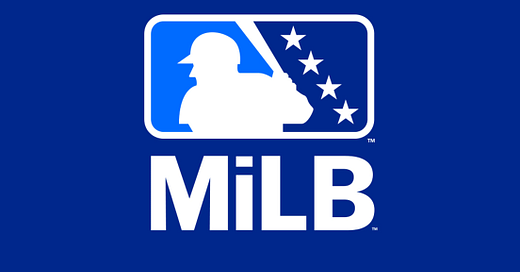Top 40 Pitching Prospects (2025 Update)
Analysis of the top 40 arms in the minor leagues accompanied by Stuff+ on EVERY arm
If you’re receiving this post in your email inbox, I encourage you to go to my substack site to read. The functionality of the tables will be friendlier.
We’re back! Here’s another update to my top 40 pitching prospects as we enter the 2025 season. My prior two editions are here and here. A reminder that my write-ups are heavily focused on what the pitcher does with their shapes and velocity, and how that interacts with their release. There are a bunch of other great lists out there that give better full-picture explanations of how a pitcher got to where he is today.
We’re at a particularly odd time in ranking pitching prospects. Pitch design has become so ubiquitous that we can assume the addition of multiple pitches to most repertoires. Everybody throwing harder than 96 mph is probably going to have some kind of arm surgery. Upon arrival in the majors, we see good fastballs get usage haircuts. Even with that said, if I could know one thing to project a pitcher, it would be fastball characteristics (shape, velocity, release).
Stuff models do a great job of pegging potential, but we also see a lot of arms debut and struggle mightily before having to make corrections or refine command. The capacity to do that is the ultimate wild card in every profile. It’s clear you’re better off being in some organizations to develop as a pitcher as opposed to others. My goal is to project these pitchers’ WAR total in their first 6 years of team control, which means I have to consider organizational track record and present aptitude (a little).
Stuff+ Notes…
For individual pitch types, Stuff+ shows that pitch’s value relative to other pitches of that pitch type. A 124 Stuff+ slider is 2 standard deviations (plus-plus) above the average MLB slider. This would equate to a pitch around the 98th percentile in MLB—a rare offering to find in the minors. Thanks to Thomas Nestico for help with the model.
Total Stuff+ distills the value of an entire repertoire into one number based on the usage of that pitch and the value each pitch type has towards run prevention. Therefore, a 100 Stuff+ slider has a lower contribution to run prevention than a 100 Stuff+ fastball.
A pitcher with a total Stuff+ of 112 would have an arsenal 1 standard deviation above the MLB average at preventing runs or an 85th-percentile MLB mix. This is very good and rare in the minors.
This scaling is slightly different compared to Eno Sarris’s model on FanGraphs, which also has a standard deviation of 12 for total Stuff+, but has different pitch type averages, where mine are all at 100.
General Notes…
Pitchers only use MLB baseballs when they reach Triple-A. Before that, they use a variant of an MLB ball. This ball inflates pitch movement for more spin-efficient arms. The consensus among those I spoke with in organizations said that high-efficiency guys are hurt the most (I’m in the process of getting data to back this up). I make note of this occasionally in the blurbs below, as I do think it’s relevant to consider.
Comps for each pitcher are aesthetic (who they remind me of on the mound visually) and/or shapes (their closest shape comps from 2024 MLB data, often based around their fastball). They are not meant to be comparisons of performance. Please don’t get mad when I comp somebody to Andrew Heaney or AJ Minter.
I’m hesitant to throttle the non-alpha-tier college arms I liked during draft season (Bryce Cunningham, Kash Mayfield) without seeing some pro-level data. It’s a blind spot of this list as I anticipate liking some of those names more than arms in my 30-40 window.
The top 5-10 relievers in baseball clear the 2-WAR threshold in a given year. That’s the standard for a 50 FV starting pitcher. Given the value placed on those high-leverage outs, the true value of a top-5 reliever from an FV perspective is probably closer to the 55 FV. Despite that value, I consider reliever projection more volatile than starter projection. Therefore, pitchers who I think have a higher probability to be starters than relievers max out around the lower end of the 50 FV tier.
I admit I’m influenced by other lists, even if it’s only creating the pool of pitchers I pick from, it’s hard not to be. But my goal on subsequent lists (2025 mid-season update and 2026) is not to look before ranking. I feel like this has a higher probability of happening if I put it in writing like this. Let’s test my willpower.
A LOWER vertical break number means MORE drop. This is a fundamental concept that will be sprinkled throughout my blurbs. My previous list had some averages for zone, chase, whiff, etc. You can view that here.
Player Notes…
Graduates - no longer eligible because of innings pitched or days on roster; shown with their present-day FV tier
Zebby Matthews (MIN, 55 FV), David Festa (MIN, 50 FV), Hayden Birdsong (SFG, 50 FV), Hurston Waldrep (ATL, 45+ FV), Drew Thorpe (CHW, 45 FV)
Fall-offs - these arms were on my 2024 midseason update, are still eligible, but are not included on this update; shown with reason for fall in no particular order
Chase Hampton (NYY, injuries), Ricky Tiedemann (TOR, injuries + reliever risk), Jairo Iriarte (CHW, stuff regression), Dylan Lesko (TBR, command), Noble Meyer (MIA, too early), Robby Snelling (MIA, need to see development), Luis Morales (ATH, too early), Chayce McDermott (BAL, casulty of better arms)




